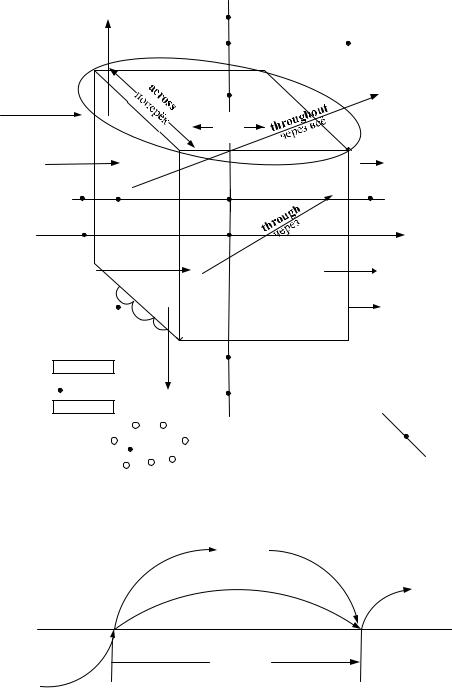
- •ВВЕДЕНИЕ
- •1.1. Исходные структурные элементы сказуемого
- •Итоговый тест
- •2.1. Основные составные элементы предложения (русско-английский вариант)
- •2.2. Словосочетание как расширение с, о, дп, ор
- •2.3. Структура простого повествовательного предложения
- •2.4. Артикль и другие определители имени существительного
- •2.4.1. Заменители артикля
- •2.4.2. Функции и значения местоимения it
- •2.4.3. Функции и значения one
- •2.5. Прилагательные и наречия
- •2.5.1. Признаки распознавания прилагательных и наречий
- •2.5.2. Прилагательные и наречия, совпадающие по форме, а также наречия, имеющие две формы
- •2.5.4. Усиление степеней сравнения прилагательных
- •2.5.5. Сравнительные конструкции
- •2.7.3. Инфинитив в функции определения
- •2.8. Предлоги
- •2.8.1. Предлоги, указывающие на местоположение
- •2.8.2. Предлоги, указывающие на время
- •2.8.3. Составные предлоги
- •Итоговый тест
- •3.3.1. Признаки распознавания функций и значений that (this, these, those)
- •3.3.2. Признаки распознавания функций и значений after
- •3.3.3. Признаки распознавания функций и значений as
- •3.3.4 Признаки распознавания функций и значений before
- •3.3.5. Признаки распознавания функций и значений for
- •3.3.6. Признаки распознавания функций и значений since
- •Итоговый тест
- •4.1. Инфинитивные обороты
- •4.1.1. Признаки распознавания определительных инфинитивных оборотов
- •4.2. Причастные обороты
- •4.2.1. Признаки распознавания причастных оборотов с причастием I
- •4.2.3. Особенности перевода определительных оборотов с причастием II
- •4.2.4. Признаки распознавания независимого причастного оборота
- •4.3. Причастие I, II и герундий
- •4.3.1. Сравнение функций причастия I и герундия
- •4.4. Герундиальные обороты
- •Итоговый тест
- •СОДЕРЖАНИЕ

V.Give the Russian equivalents of the following sentences.
1.The substance obtained contained some admixtures. 2. Then we discussed the quality of the machine tested. 3. The equipment produced is of high quality. 4. The device invented showed good performance. 5. The complexity of the technique involved increased considerably. 6. The results achieved confirmed the theoretical assumptions. 7. The investigation carried out provided both decryption keys and decryption applications. 8. Engineers should wait for the manager to officially accept proposed changes before implementing them.
2.7.3. Инфинитив в функции определения
1 X to х /to be хed
↓
после определяемого существительного → инфинитив в действительном/ чаще страдательном залоге (Infinitive Active/Passive) → какой? = который нужно сделать/который будет делаться1
The problem to consider next is |
a) |
Проблема, |
которую |
нужно |
|
concerned with data transmission. |
рассмотреть |
далее, |
касается |
||
|
передачи данных. |
|
|
|
|
|
b) |
Проблема, |
которая |
|
будет |
|
рассматриваться |
далее, |
касается |
||
|
передачи данных. |
|
|
|
|
The terms to be insisted on are as follows. |
a) Условия, на которых |
надо |
|||
|
настаивать, |
заключаются |
в |
||
|
следующем. |
|
|
|
|
|
b) Условия, на которых будут |
||||
|
настаивать, |
заключаются |
в |
||
|
следующем. |
|
|
|
|
2 to х/ to be хed
↓
после порядковых числительных (the first, the second) или прилагательного the last → инфинитив в действительном или страдательном залоге (Infinitive Active/Passive) = заменяет придаточное определительное.
He was the first to answer the question. |
Он первым ответил на вопрос. |
(He was the first who answered the |
|
question.) |
|
His was the last test to be checked. (His |
Его тест проверили последним. |
was the last test which was checked.) |
|
1 Инфинитив в функции определения заключает в себя модальный оттенок долженствования, возможностей (иногда желания) (a) или передаёт будущее время в зависимости от ситуации и переводится на русский язык определительным придаточным предложением, с оттенком значения, указанным выше (b).
58
I. Find the Infinitive and name its features. Model these sentences.
1.The x to be xed xs on the x.
2.The x to be xed is xed on x x of the x.
3.The x was the x to be xed in x.
4.The x to x is xed with x x.
5.The x was the first to x the x.
II. Give the Russian equivalents of the following word combinations. Define what the attribute is expressed by.
The problem to be solved; the remark made; the new technology to be introduced; the theory to be considered; the tested equipment; the tool to be used; the distance travelled; the message sent; the experiment to be carried out; the software developed.
III. Define the features of the Infinitive in the function of an attribute. Give the Russian equivalents of the following sentences.
1. The procedure to be followed depends upon the substance being tested. 2. We observed the evaporation of water, a phenomenon to be more fully described later. 3. The method to be followed is based upon some peculiar properties of these rays. 4. Here are some more figures to be referred to later. 5. Alpha-radiation was the first radiation to be studied in detail. 6. There was only one signal to be detected. 7. There are some other properties of a metal to be considered at this point.
IV. Give the Russian equivalents of the following nouns, pay attention to the meanings of the words from which they are derived.
Insulation (insulate – изолировать); measurement (measure – измерять); transmission (transmit – передавать); prevention (prevent – предотвращать; препятствовать); resistance (resist – сопротивляться); carrier (carry – нести).
V. Match each word or word combinations with the correct equivalent.
destination |
частота |
medium |
жила |
twisted-pair wire |
скручивать |
frequency |
пропускная способность |
avoid |
среда, средство |
layer |
полоса пропускания |
strand |
адресат информации |
twist |
избегать |
bandwidth |
слой, уровень |
capacity |
витая пара |
VI. Arrange in pairs the words and word-combinations with a) similar meaning,
b)contrary meaning:
a)ground, immune, repeater station, earth, situate, conventional, nonsusceptible, obstacle, locate, obstruction, relay station, common;
b)invisible, inside, wireless, internal, expensive, outside, visible, wired, cheap,
external.
59
VII. In the text of task VIII find the word derived from the verb to transmit. Name other derivatives of this verb.
VIII. Read the text and choose the most suitable title:
1.Communications channels.
2.Wireless Communication.
3.Types of Cables.
1.A communications channel is the physical medium, through which information travels from its source to its destination. A communications channel is rated by its channel capacity or bandwidth and measured in bits per second.
2.Cable. Cable includes twisted-pair wire and coaxial cable. Twisted-pair wire consists of two strands of insulated copper wire, twisted around each other and covered in another layer of plastic insulation. Much of the world is served by twistedpair wire, both for voice messages and for modem-transmitted computer data. Coaxial cable consists of insulated copper wire wrapped in a metal shield, then in an external cover. The shield is grounded and prevents the cable from picking up or emitting electrical noise, thus, coaxial cable is much better at resisting noise than twisted-pair wiring.
3.Fiber-optic cable. Unlike cables that carry data as electrical signals at radio frequencies, fiber-optic (FO) cable uses infrared or visible light to transmit information as laser-generated pulses of light. It carries much more signals than conventional copper wire, which makes transmission of information faster and less expensive than copper wire transmission, and is totally immune to electromagnetic interference.
4.Wireless communication. There are many situations in which it is difficult to lay wires. Data can be transmitted via electromagnetic waves and satellite links. Microwave earth stations transmit voice and data through the atmosphere as highfrequency radio waves, even if slower than via fiber-optic cable. As microwave signals travel in a straight line from source to destination, to avoid obstructions and the curvature of the earth, they need to be beamed several times by repeater stations situated on top of high places so that the antennas are in line of sight of each other, or by communications satellites. At very high frequencies (VHF) and above, many communications circuits use satellites in geostationary orbits (GEO) around the earth.
IX. In passage 1 find the definition of a communications channel and its main features.
X. Look through passage 2 and explain the difference between twisted-pair and coaxial cable.
XI. Read passage 3 and name the advantages of fiber-optic cable as compared to copper cable.
XII. Read the second sentence of passage 4 and divide it into sense groups. Define the dependency relations between them.
60

XIII. Say whether the following statements are true (T) or false (F). Correct the false ones.
1.Twisted-pair wire is used only for transmitting voice messages.
2.Coaxial cables are more susceptible to electromagnetic interference.
3.Fiber-optic cables are used to transmit data in the form of electric pulses.
4.Wireless communication is greatly influenced by obstacles, so microwave signals need amplification.
XIV. Translate passage 4 into Russian.
|
|
2.8. Предлоги |
|
|
2.8.1. Предлоги, указывающие на местоположение |
||||
up |
|
|
over |
|
|
|
сверху |
|
|
вверх |
around |
|
|
out |
|
|
above |
вне |
|
|
вокруг |
|
||
|
|
|
||
|
|
над |
|
|
|
|
|
|
|
|
|
|
on |
|
toward |
|
|
на |
|
|
|
|
|
|
по направлению |
|
|
along |
|
|
|
|
вдоль |
|
to |
|
|
|
off |
к |
|
|
|
от |
in front of |
at |
|
in |
behind |
перед |
у |
|
в |
позади |
near |
|
inside |
|
|
вблизи, |
|
внутри |
|
|
около |
|
|
|
|
|
into |
|
out of |
|
внутрь |
|
|
||
|
изнутри |
|
||
|
|
|
|
|
about |
|
|
|
|
о, около |
|
|
from |
|
|
|
|
|
|
|
|
|
|
из |
|
|
down |
under |
|
|
|
вниз |
под |
|
between |
|
|
below |
|
между |
|
|
|
|
|
|
|
ниже |
|
|
among |
|
|
against |
|
|
|
против |
|
|
среди |
|
|
|
2.8.2. Предлоги, указывающие на время |
||||
since |
till (until) |
|
с |
|
|
до |
|
|
|
|
|
|
|
after |
|
during |
после |
|
|
|
|
в течение |
|
before |
within |
|
перед |
||
в рамках |
||
|
61

Запомните значение следующих предлогов
FOR |
ДЛЯ |
BY |
(ЧЕМ) |
WITH |
С |
WITHOUT |
БЕЗ |
AS |
КАК |
OF |
(ЧЕГО, КОГО) |
|
|
ON = UPON |
НА |
I. Define the meaning of the prepositions choosing the correct variant.
1. toward: |
a) от |
b) по направлению к с) |
через |
d) между |
e) без |
||
2. out of: |
a) на |
b) среди |
c) |
изнутри |
d) под |
e) над |
|
3. down: |
a) из |
b) в течение |
c) |
вверх |
d) вниз |
e) около |
|
4. through: |
a) вдоль |
b) через |
c) |
между |
d) от |
e) до |
|
5. from: |
a) после |
b) над |
с) |
среди |
d) на |
e) от |
|
6. up: |
a) ниже |
b) вверх |
c) |
под |
d) внутрь |
e) поперек |
|
7. around: |
a) сверху b) в |
|
c) |
вокруг |
d) ниже |
e) через всё |
|
8. between: a) под |
b) в течение |
c) до |
d) между |
e) позади |
|||
II. In each line find prepositions of place and give their Russian equivalents. |
|||||||
1. a) till |
b) near |
|
c) out of |
d) from |
e) between |
f) at |
|
2. a) among |
b) since |
|
c) before |
d) up |
e) throughout |
f) under |
|
3. a) from |
b) to |
|
c) behind |
d) after |
e) within |
f) till |
|
4. a) during |
b) through |
c) above |
d) into |
e) at |
f) toward |
||
5. a) within |
b) after |
|
c) across |
d) over |
e) down |
f) to |
|
6. a) against |
b) before |
c) at |
d) off |
e) without |
f) for |
||
7. a) by |
b) for |
|
c) below |
d) on |
e) out of |
f) with |
|
8. a) since |
b) along |
|
c) of |
d) for |
e) through |
f) in |
|
III. In each line find prepositions of time and name their Russian equivalents.
1. a) since |
b) across |
c) over |
d) from |
e) at |
f) into |
2. a) against |
b) down |
c) to |
d) till |
e) toward |
f) near |
3. a) up |
b) during |
c) through |
d) around |
e) between |
f) out of |
4. a) off |
b) among |
c) into |
d) before |
e) above |
f) without |
5. a) after |
b) under |
c) among |
d) throughout |
e) to |
f) with |
6. a) across |
b) behind |
c) along |
d) until |
e) of |
f) below |
7. a) into |
b) during |
c) on |
d) over |
e) below |
f) among |
8. a) within |
b) between |
c) behind |
d) down |
e) out |
f) against |
IV. Choose the preposition the translation of which is given at the beginning of
each line. |
|
|
|
|
|
|
1. |
в течение: |
a) around |
b) near |
c) behind |
d) on |
e) during |
2. |
среди: |
a) since |
b) through |
c) around |
d) above |
e) among |
3. |
между: |
a) by |
b) between |
c) for |
d) under |
e) above |
62 |
|
|
|
|
|
|
